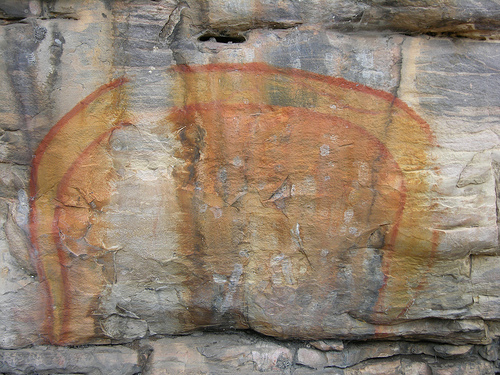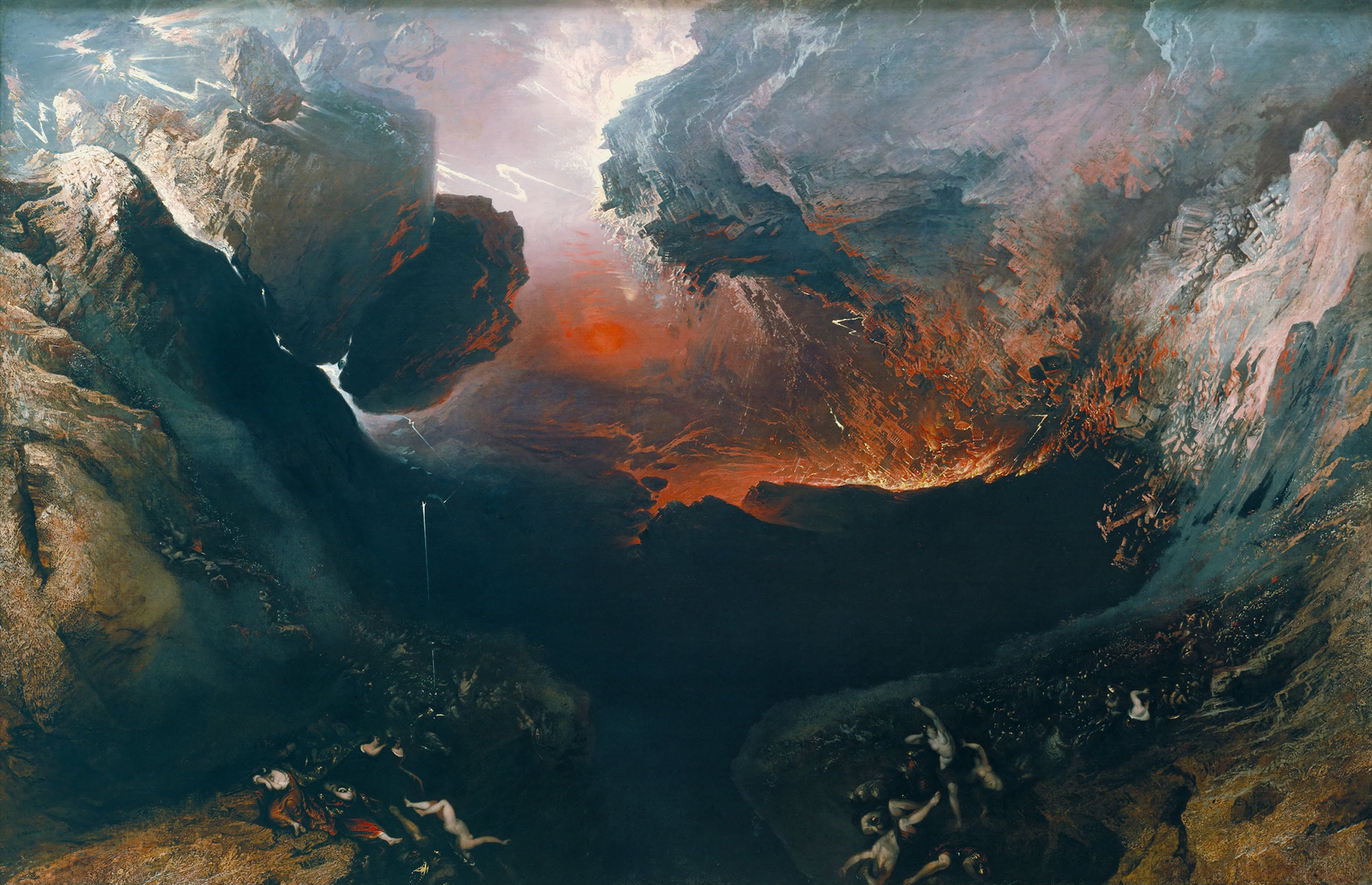|
Minawara And Multultu
In Aboriginal mythology, Minawara and Multultu were the legendary ancestors of the Nambutji tribe. They were a kangaroo-men, They are part of a tribe that lives peacefully in their village, but until the Deities give their tribe a divine punishment because someone violated a sacred oath in the village. It causes the Deities fulled by anger and sent the Great Flood to sweep away their village. Minawara and Multultu were tossed here and there, carried by the waves that slaughterer their entire families, their memories and the place where they grew up. To the point where it finally stopped. They stopped with a pile of debris carried away by the Great Flood. They begin their long journey into the void, without direction or any kind of clues of where they should go or do. They been walking nonstop, no food neither drink, just them and their unbreakable determination to keep going. Along the way, they little by little lose their worldliness. Their noses are damaged because they are ... [...More Info...] [...Related Items...] OR: [Wikipedia] [Google] [Baidu] |
Aboriginal Mythology
Australian Aboriginal religion and mythology is the sacred spirituality represented in the stories performed by Aboriginal Australians within each of the language groups across Australia in their ceremonies. Aboriginal spirituality includes the Dreamtime (''the Dreaming''), songlines, and Aboriginal oral literature. Aboriginal spirituality often conveys descriptions of each group's local cultural landscape, adding meaning to the whole country's topography from oral history told by ancestors from some of the earliest recorded history. Most of these spiritualities belong to specific groups, but some span the whole continent in one form or another. Antiquity An Australian linguist, R. M. W. Dixon, recording Aboriginal myths in their original languages, encountered coincidences between some of the landscape details being told about within various myths, and scientific discoveries being made about the same landscapes. In the case of the Atherton Tableland, myths tell of the or ... [...More Info...] [...Related Items...] OR: [Wikipedia] [Google] [Baidu] |
List Of Australian Aboriginal Mythological Figures
The following is a list of Australian Indigenous Australian deities and spirits. New South Wales * Baiame, creator god of the peoples of New South Wales *Baloo, Kamilaroi moon god who keeps three pet snakes *Birrahgnooloo, Kamilaroi goddess of fertility who would send floods if properly asked to *Daramulum, sky hero and son of Baiame and Birrahngnooloo * Dirawong, Bundjalung creator being *Ganhanbili, second wife of Baiame * Wurrunna, culture hero * Yhi, Kamilaroi solar goddess associated with light and creation Northern Territory * Adnoartina, the lizard guard of Uluru *Altjira, Arrernte sky god who created the earth * Ankotarinja, first man of Arrernte mythology * Onur, Karraur lunar deity *Bamapana, Yolngu trickster spirit who creates discord * Banaitja, creator deity * Barnumbirr, Yolngu creator spirit *Barraiya, creator of the first vagina *Bobbi-Bobbi, benevolent Binbinga snake deity *Djanggawul, three creator-siblings of northeast Arnhem Land mythology *Galeru, ... [...More Info...] [...Related Items...] OR: [Wikipedia] [Google] [Baidu] |
Warlpiri People
The Warlpiri, sometimes referred to as Yapa, are a group of Aboriginal Australians defined by their Warlpiri language, although not all still speak it. There are 5,000–6,000 Warlpiri, living mostly in a few towns and settlements scattered through their traditional land in the Northern Territory, north and west of Alice Springs. About 3,000 still speak the Warlpiri language. The word "Warlpiri" has also been romanised as Walpiri, Walbiri, Elpira, Ilpara, and Wailbri. Language The Warlpiri language is a member of the Ngumpin-Yapa subgroup of the Pama-Nyungan family of languages. The name ''Yapa'' comes from the word for "person", and is also used by the Warlpiri people to refer to themselves, as Indigenous people rather than "kardiya" (non-Indigenous). The closest relative to Warlpiri is Warlmanpa. It has four main dialects; Yuendumu Warlpiri, in the south-west, Willowra Warlpiri, in the central area, around the Lander River, the northern dialect, Lajamanu Warlpiri, and the ... [...More Info...] [...Related Items...] OR: [Wikipedia] [Google] [Baidu] |
Kangaroo
Kangaroos are four marsupials from the family Macropodidae (macropods, meaning "large foot"). In common use the term is used to describe the largest species from this family, the red kangaroo, as well as the antilopine kangaroo, eastern grey kangaroo, and western grey kangaroo. Kangaroos are indigenous to Australia and New Guinea. The Australian government estimates that 42.8 million kangaroos lived within the commercial harvest areas of Australia in 2019, down from 53.2 million in 2013. As with the terms "wallaroo" and "wallaby", "kangaroo" refers to a paraphyletic grouping of species. All three terms refer to members of the same taxonomic family, Macropodidae, and are distinguished according to size. The largest species in the family are called "kangaroos" and the smallest are generally called "wallabies". The term "wallaroos" refers to species of an intermediate size. There are also the tree-kangaroos, another type of macropod, which inhabit the tropical ra ... [...More Info...] [...Related Items...] OR: [Wikipedia] [Google] [Baidu] |
Deity
A deity or god is a supernatural being who is considered divine or sacred. The ''Oxford Dictionary of English'' defines deity as a god or goddess, or anything revered as divine. C. Scott Littleton defines a deity as "a being with powers greater than those of ordinary humans, but who interacts with humans, positively or negatively, in ways that carry humans to new levels of consciousness, beyond the grounded preoccupations of ordinary life". Religions can be categorized by how many deities they worship. Monotheistic religions accept only one deity (predominantly referred to as "God"), whereas polytheistic religions accept multiple deities. Henotheistic religions accept one supreme deity without denying other deities, considering them as aspects of the same divine principle. Nontheistic religions deny any supreme eternal creator deity, but may accept a pantheon of deities which live, die and may be reborn like any other being. Although most monotheistic religions traditionall ... [...More Info...] [...Related Items...] OR: [Wikipedia] [Google] [Baidu] |
Divine Retribution
Divine retribution is supernatural punishment of a person, a group of people, or everyone by a deity in response to some action. Many cultures have a story about how a deity exacted punishment upon previous inhabitants of their land, causing their doom. An example of divine retribution is the story found in many cultures about a great flood destroying all of humanity, as described in the Epic of Gilgamesh, the Hindu Vedas, or Book of Genesis (6:9–8:22), leaving one principal 'chosen' survivor. In the first example, it is Utnapishtim, and in the last example Noah. References in the New Testament and the Quran to a man named Nuh (Noah) who was commanded by God to build an ark also suggest that one man and his followers were saved in a great flood. Other examples in Hebrew religious literature include the dispersion of the builders of the Tower of Babel (Genesis 11:1–9), the destruction of Sodom and Gomorrah (Genesis 18:20–21, 19:23–28) ( Quran 7:80–84), and the Ten Plag ... [...More Info...] [...Related Items...] OR: [Wikipedia] [Google] [Baidu] |
Flood Myth
A flood myth or a deluge myth is a myth in which a great flood, usually sent by a deity or deities, destroys civilization, often in an act of divine retribution. Parallels are often drawn between the flood waters of these Mythology, myths and the primaeval water (classical element), waters which appear in certain creation myths, as the flood waters are described as a measure for the social cleansing, cleansing of humanity, in preparation for wikt:rebirth, rebirth. Most flood myths also contain a culture hero, who "represents the human craving for life". The List of flood myths, flood-myth motif Aarne–Thompson–Uther Index, occurs in many cultures, including the Mesopotamian flood stories, Native American in North America, the Genesis flood narrative, ''manvantara-sandhya'' in Hinduism, and Deucalion and Pyrrha in Greek mythology. Mythologies One example of a flood myth is the ''Epic of Gilgamesh''. Many scholars believe that this account was copied from the Akkadian language, ... [...More Info...] [...Related Items...] OR: [Wikipedia] [Google] [Baidu] |
Deluge (mythology)
A flood myth or a deluge myth is a myth in which a great flood, usually sent by a deity or deities, destroys civilization, often in an act of divine retribution. Parallels are often drawn between the flood waters of these myths and the primaeval waters which appear in certain creation myths, as the flood waters are described as a measure for the cleansing of humanity, in preparation for rebirth. Most flood myths also contain a culture hero, who "represents the human craving for life". The flood-myth motif occurs in many cultures, including the Mesopotamian flood stories, Native American in North America, the Genesis flood narrative, ''manvantara-sandhya'' in Hinduism, and Deucalion and Pyrrha in Greek mythology. Mythologies One example of a flood myth is the ''Epic of Gilgamesh''. Many scholars believe that this account was copied from the Akkadian '' Atra-Hasis'', which dates to the 18th century BCE. In the Gilgamesh flood myth, the highest god, Enlil, decides ... [...More Info...] [...Related Items...] OR: [Wikipedia] [Google] [Baidu] |
The Dreaming
The Dreaming, also referred to as Dreamtime, is a term devised by early anthropologists to refer to a religio-cultural worldview attributed to Australian Aboriginal beliefs. It was originally used by Francis Gillen, quickly adopted by his colleague Baldwin Spencer and thereafter popularised by A. P. Elkin, who, however, later revised his views. The Dreaming is used to represent Aboriginal concepts of ''Everywhen'', during which the land was inhabited by ancestral figures, often of heroic proportions or with supernatural abilities. These figures were often distinct from gods, as they did not control the material world and were not worshipped but only revered. The concept of the Dreamtime has subsequently become widely adopted beyond its original Australian context and is now part of global popular culture. The term is based on a rendition of the Arandic word ''alcheringa'', used by the Aranda (Arunta, Arrernte) people of Central Australia, although it has been argued tha ... [...More Info...] [...Related Items...] OR: [Wikipedia] [Google] [Baidu] |
Australian Aboriginal Mythology
Australian Aboriginal religion and mythology is the sacred spirituality represented in the stories performed by Aboriginal Australians within each of the Aboriginal Australian languages, language groups across Australia in their Aboriginal ceremonies, ceremonies. Aboriginal spirituality includes The Dreaming, the Dreamtime (''the Dreaming''), songlines, and Aboriginal oral literature. Aboriginal spirituality often conveys descriptions of each group's local cultural landscape, adding meaning to the whole country's topography from oral history told by ancestors from some of the earliest recorded history. Most of these spiritualities belong to specific groups, but some span the whole continent in one form or another. Antiquity An Australian Linguistics, linguist, R. M. W. Dixon, recording Aboriginal myths in their original languages, encountered coincidences between some of the landscape details being told about within various myths, and Hard science, scientific discoveries bein ... [...More Info...] [...Related Items...] OR: [Wikipedia] [Google] [Baidu] |
Legendary Mammals
Legendary may refer to: * Legend, a folklore genre * Legendary (hagiography) ** Anjou Legendarium * J. R. R. Tolkien's legendarium Film and television * ''Legendary'' (film), a 2010 American sports drama film * ''Legendary'', a 2013 film featuring Dolph Lundgren * ''Legendary'' (TV series), a 2020 American reality competition series * "Legendary" (''Legends of Tomorrow''), a television episode Music Albums * ''Legendary'' (AZ album), 2009 * ''Legendary'' (The Summer Set album) or the title song, 2013 * ''Legendary'' (TQ album) or the title song, 2013 * ''Legendary'' (Tyga album) or the title song, 2019 * ''Legendary'' (Z-Ro album), 2016 * ''Legendary'' (Zao album), 2003 * ''Legendary'', by Kaysha, 2006 * ''The Legendary'', an EP by the Roots, 1999 Songs * "Legendary" (Deadmau5 and Shotty Horroh song), 2017 * "Legendary" (Welshly Arms song), 2016 * "Legendary", by Alaska Thunderfuck from ''Anus'', 2015 * "Legendary", by Daya from '' Daya'', 2015 * "Legendary", by R ... [...More Info...] [...Related Items...] OR: [Wikipedia] [Google] [Baidu] |







